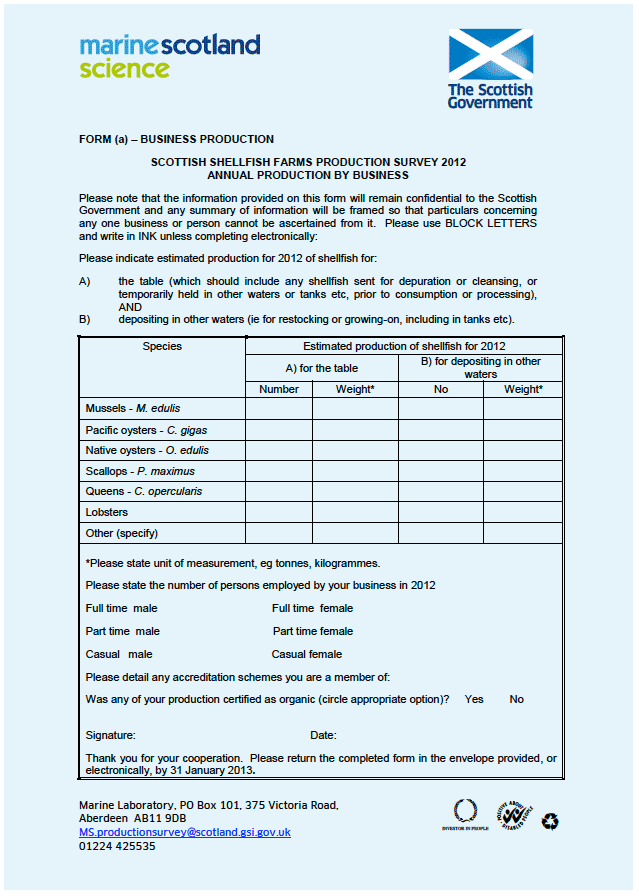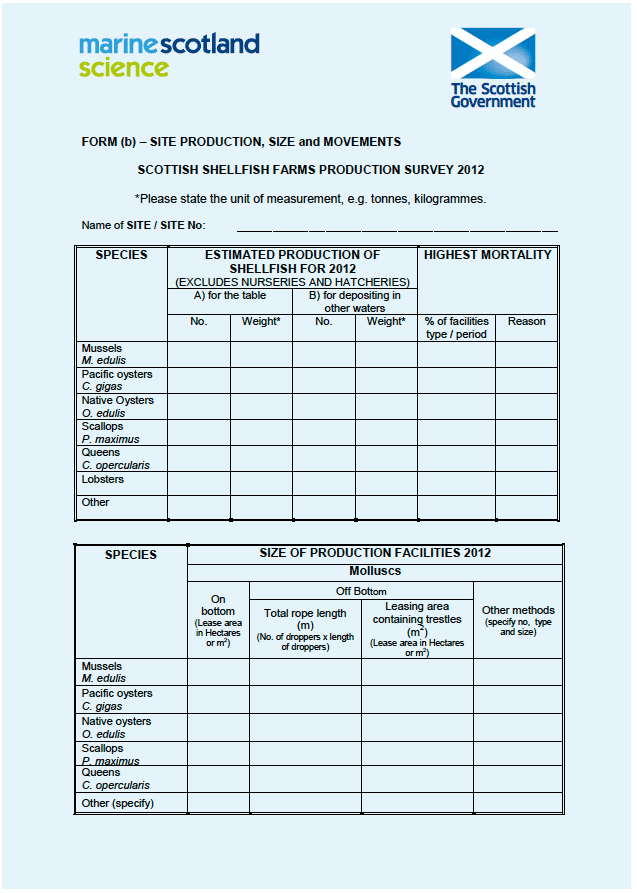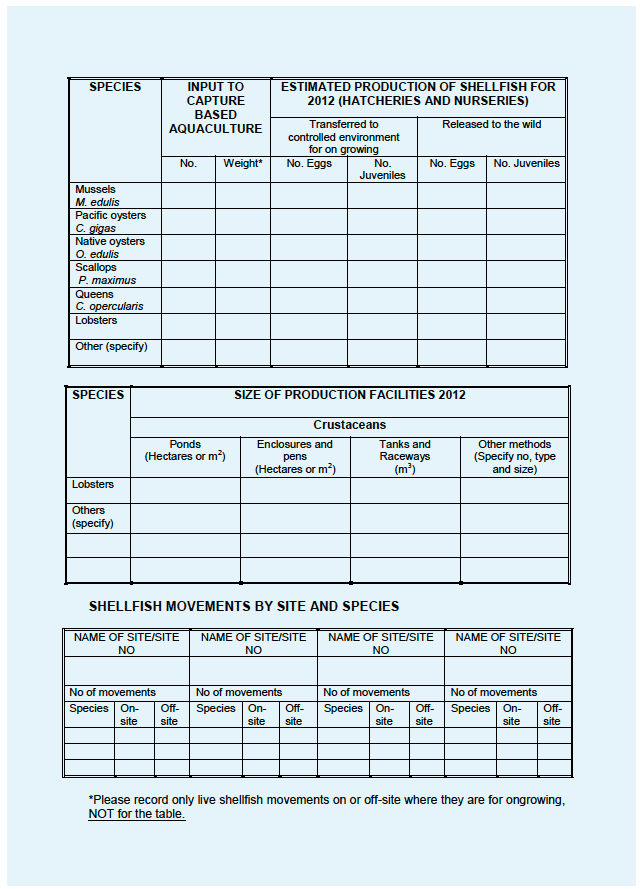Scottish Shellfish Farm Production Survey: 2012 Report
This report is based on the returns of an annual survey questionnaire sent to all active authorised shellfish farming businesses in Scotland.
This document is part of a collection
Appendix 1: Covering Letter and Guidance Notes
Ref no: A4625727
10 th December 2012
Dear Sir/Madam
ANNUAL RETURNS OF SHELLFISH FARM PRODUCTION - 2012
For the year 2012 we seek production data from your business and site(s).
I enclose forms requesting information on your shellfish farming enterprise and a self‑addressed envelope for their return. Alternatively these forms can be issued electronically upon request by contacting MS.productionsurvey@scotland.gsi.gov.uk providing business name, number and correspondent name. FORMS (a) & (b) will then be issued to you electronically for completion and return to MS.productionsurvey@scotland.gsi.gov.uk.
The data you supply to Marine Scotland is of great assistance to your industry and the Scottish Government. It is our intention to continue to publish the data in a summarised form in the SGMD Scottish Shellfish Farms Annual Production Survey 2012 which should be available in the spring of 2013.
Marine Scotland is obliged to consider any request it receives in relation to this under the Freedom of Information (Scotland) Act 2002 ( FOISA) and the Environmental Information (Scotland) Regulations 2004 ( EISRs).
FORM (a) requests data on production by business.
FORM (b) requests data on production, facility size and number of shellfish movements by site(s) and by species. Guidance notes are enclosed.
FORM (b) can accommodate one site return. If your business operates more than one site, extra forms have been provided. Please note that production recorded by business must equal total production recorded by site. If the business has a nil return please place an X against the species registered as cultured, in FORM (a). This data will allow a more accurate reflection of site production both geographically and by species. Input into capture based aquaculture should be recorded on form (b). Recording of movements of live shellfish for on-growing ( NOT for the table ), on or off‑site, should be recorded on FORM (b).
Please note that it is your duty to notify a competent authority or a veterinarian if you know or suspect that increasing mortality has occurred or is occurring in aquaculture animals in accordance with the Aquatic Animal Health (Scotland) Regulations 2009. See guidance notes for reporting of mortality events where appropriate and registration changes.
Thank you for your co-operation. If you have any queries regarding the survey, please do not hesitate to contact me at the address given below, or telephone 01224 425535 or e-mail MS.productionsurvey@scotland.gsi.gov.uk
Please send returns to me by post, or electronically, before 31 st January 2013.
Yours faithfully,
Lorna Munro
Marine Scotland Science
Form (a) - Business Production

Form (b) - Site Production, Size and Movements


Guidance on completion of the survey forms
Business Production Form (a)
Please check your business title and address at the top of the page. If you are no longer the correspondent for the business then please notify the Fish Health Inspectorate ( FHI, details below) and your details can be changed on our database. If the business is no longer producing shellfish or the lease for the site has been lost or sold, the FHI will have to be informed.
Please provide your total business production next to the relevant species (the individual site production should add up to the total business production form). The weight and number of shells produced should also be stated in the correct column. The 'for the table' column is for shellfish sold for human consumption (which should include any shellfish sent for depuration or cleansing, or temporarily held in other waters or tanks etc, prior to consumption or processing), and the column 'for depositing in other waters' should be filled in when shellfish have been partially grown and then sold or transferred to another business for on-growing. Please state the unit of measurement used in your total business production ( e.g. kilograms, tonnes etc.). If your business has not produced any shellfish then please put an X next to the species of shellfish that is authorised to be grown on site.
Employment section: please state the number of people employed in the business under the following headings; full time male, full time female, part-time male, part-time female, casual (occasionally employed) male, or casual female.
Accreditation schemes; please include membership to trade associations, quality schemes or organic certification schemes (for example Association of Scottish Shellfish Growers, Tartan Quality Mark, Soil Association).
Please finish the form by signing and dating.
Site Production, Size and Movements - Form (b)
Shellfish Mortality
- It is your duty to notify the competent authority or a veterinarian if you know or suspect that increasing mortality has occurred or is occurring in aquaculture animals in accordance with the Aquatic Animal Health (Scotland) Regulations 2009. This should be interpreted as being where mortality affects 15% or greater of stocks in a single facility, over a short period. It is also a requirement to maintain mortality records detailing the number of any aquaculture animals that have died in each epidemiological unit within the area. Where significant abnormal mortalities occur, our Duty Inspector ( DI) should be informed immediately stating suspected cause (if known). You will then be contacted to discuss the possible need for a diagnostic investigation of the case. Copies of movement records should be included in the correspondence. The DI can be contacted by telephone on 01224 295525, by Fax on 01224 295620 or by e-mail at MS.fishhealth@scotland.gsi.gov.uk
- Please indicate in the box provided on FORM (b), the highest mortality as a percentage (%) of the facility type, for each species registered as cultured. Mortality should be recorded over a defined period of time. Please also indicate the reason for this mortality if known, in the box provided on FORM (b). Examples are given below.
Example 1 - A mussel farmer has ten long lines and one line suffers total mortality through predation over one month. The highest % mortality recorded would be 10% / 1 month. Reason was eider duck predation.
Example 2 - An oyster farmer has 100 trestles and shellfish from 90 are lost through disease in spring. The highest % mortality recorded would be 90% / 3 months. Reason was suspect notifiable disease eg. Bonamia
Example 3 - A scallop farmer has 50 long lines and one line is destroyed by storm damage during the year. The highest % mortality recorded would be 2% / 12 months. Reason was storm damage.
Facility Size
The form can accommodate one site return. If your business operates more than one site, extra forms have been provided. If more forms are needed then please contact the Fish Health Inspectorate to acquire more sheets. You have been issued with forms appropriate to the details which we hold for your sites. If you held species in 2012 which are not listed on the form please specify these in the row marked 'Other'.
Conversion factors have been supplied below.
Molluscs
- Where molluscs are cultured on the seabed, or where a Several Order is in place the total extent of the lease area should be recorded in hectares or metres squared (m 2) (please specify) in the column titled 'On bottom'.
- Where molluscs are cultured on long lines / rafts please record the total length of rope used in metres (= number of droppers x length of droppers used) in the column titled 'Off Bottom' and subititled 'Total rope length (m)'.
- Where molluscs are cultured in trestles please record the total extent of the lease area in hectares or metres squared (m 2) (please specify) in the column titled 'Leasing area containing trestles'
- If molluscs are cultured by more than one method on a site an entry should be recorded for both methods.
- If utilising types of culturing methods other than those specified please give details of the type, number and size in the column titled 'Other methods'.
Crustaceans
- On sites holding lobsters, either for release to the wild or for placing on the market, data is required only for those facilities where the animals are being fed.
- The size of each type of holding facility being utilised for these purposes should be recorded:
- For ponds, enclosures and pens, the bottom area should be recorded in either hectares or m 2
- For tanks and raceways the volume should be recorded in m 3
Capture-Based Aquaculture
Capture based aquaculture refers to the practice of collecting aquatic animals from the wild for aquaculture purposes prior to placing on the market. For the purposes of this survey this does not include the natural settlement of mussel, oyster or scallop spat on long lines or the seabed.
The active capture of animals from the wild which are then held for a period of time prior to being placed on the market should be recorded only where those animals are being fed. There is no requirement to record those animals which are intended for release back into the wild or are not being fed.
For example:
- Wild caught oysters held temporarily in depuration facilities would not be recorded
- Wild caught lobsters held temporarily in holding facilities and being fed would be recorded
Note: Minimum landing sizes for shellfish are laid down in Annex XII of Council Regulation ( EC) No. 850/98 for the conservation of fishery resources through technical measures for the protection of juveniles of marine organisms. The minimum size for scallops ( Pecten maximus) is 100mm and as such it is illegal to retain on board, tranship, land, transport, store, sell, display or offer for sale undersized animals of this species. Juveniles and spat for relaying must be sourced from aquaculture establishments only.
Conversions
| To convert | To | Multiply (X) or divide (/) by |
|---|---|---|
| Yards | Metres | X 0.9144 |
| Miles | Kilometres | X 1.609 |
| Acres | Hectares | X 0.4047 |
| Square Metres | Hectares | / 10000 |
| Cubic feet (ft 3) | Cubic metres (m 3) | X 0.0283 |
Contact
There is a problem
Thanks for your feedback